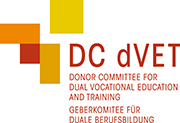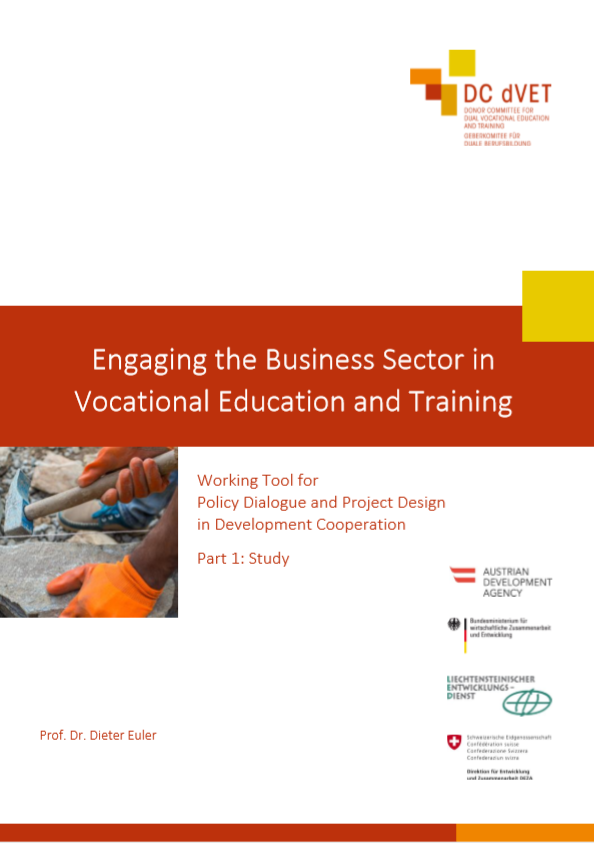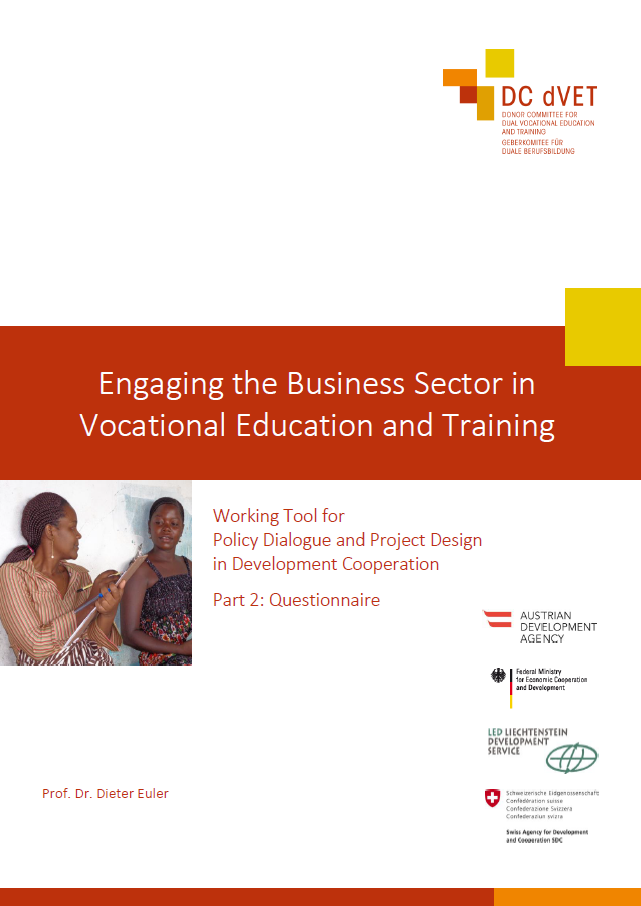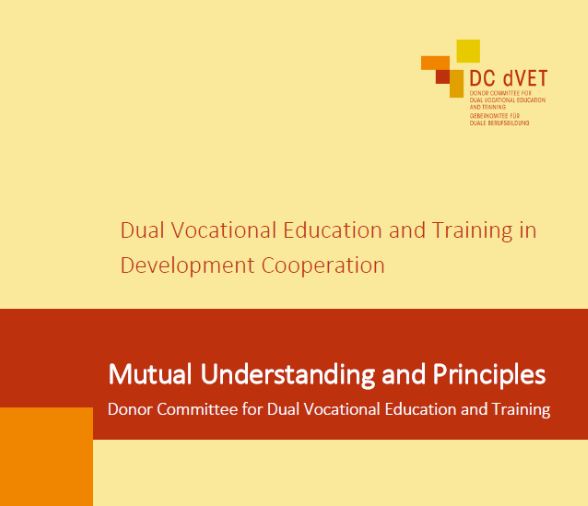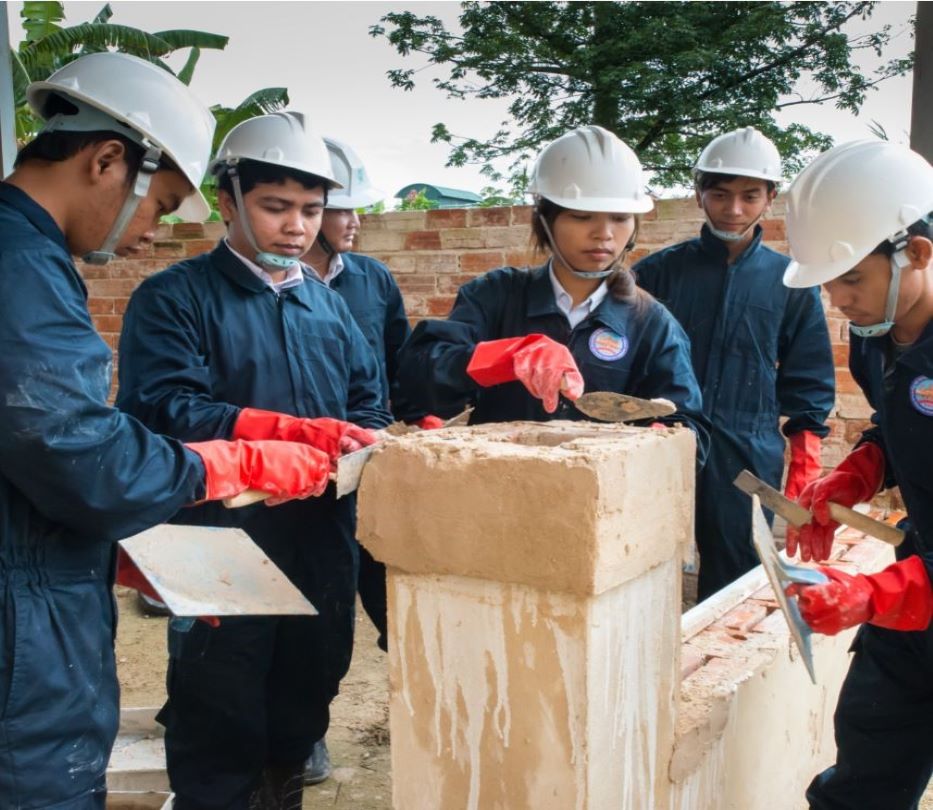Offer to DC dVET Members and Projects
The Donor Committee offers the possibility to discuss the completed questionnaire in the frame of an advisory (long-distance) talk with the DC dVET Secretariat and a technical expert.
Who is Behind the Working Tool?
The working tool has been developed by Prof. Dr. D. Euler (Institute of Business Education and Educational Management, University of St. Gallen), on behalf of the Donor Committee for dual Vocational Education and Training (DC dVET).
Who Benefits from the Working Tool?
The working tool supports donors, project collaborators and other players in the field of development cooperation in their policy dialogue and in the implementation of VET projects and programs.
What is the Purpose of Part 2 (Questionnaire)?
The questionnaire supports you in applying the considerations of the study to your own project. In addition, it helps you to structure the dialogue and negotiations within project teams or with partners from the business sector, ministries and other stakeholders. The web-based version of the questionnaire allows you to enter your answers quickly and subsequently provides you with a summary of the data.
What Does Part 1 (Study) Provide?
The study
- explains the goals to be achieved by VET and why cooperation with the business sector is essential. In addition, it provides information on particularly relevant framework conditions;
- defines within the so-called ‘reference framework’ different areas of (enhanced) engagement;
- offers useful hints for the implementation of the presented elements within a project, including a catalogue of arguments for dialogue with the business sector.
What is the Purpose of the Working Tool?
The working tool reveals how the relevance, quality and attractiveness of VET can be increased by an (enhanced) engagement of the business sector. It includes two parts:
- Part 1 (Study) offers a theoretical overview on where, how and under what conditions the private sector can be involved.
- Part 2 (Questionnaire) enables you to transfer key elements of the study to your work. It facilitates systematic analysis, planning and further development of your VET project and ideas.
The following video by the author provides you an outline of the key ideas.
Voices from the Field
Explore some feedbacks from practitioners on the DC dVET Working Tool:
For privacy reasons YouTube needs your permission to be loaded. For more details, please see our Impressum & Datenschutz.I Accept
- “I think the questionnaire is a very valuable instrument for approaching the analysis of the current TVET schemes, especially when working with new countries.
- The questionnaire is not that long, it includes very relevant questions, that would have been super useful to have when we first approached countries in Latin America. The questions can be applied to most countries.
- The term “informal apprenticeships” could be explained more in detail, because it was not clear what it includes.
- I congratulate Prof. Euler and the team for developing this tool. I look forward to applying it in new countries.”
- “The private sector plays a crucial role for demand-driven and practice-oriented TVET. Where there is little experience with cooperative TVET systems, convincing arguments are needed to highlight the benefits TVET can provide to companies.
- Arguments that address the costs and benefits of TVET in a comprehensive manner enable development advisors to talk “business” with the private sector.
- This DC dVET study offers such practical arguments. GIZ’s BuildSkills project has adapted these arguments in its advocacy paper “Return on Investment or an Investment without Return” to the Pakistani context, illustrating them with experiences of local companies. Additionally, a comparison of the differences between the German and Swiss TVET system is also displayed. The paper shows how companies can gain benefit from engaging in TVET.”
- “I am a Trainee at GIZ and have done different secondments at the ILO Lebanon, at the GIZ Morocco, and currently at the BMZ in Germany, division West Africa.
- During my work and before, during my Master’s Programme, I have used the Working Tool a lot, but mainly in an unconventional way.
- I used it amongst others as a basis for an ILO study on Lifelong Learning (LLL) in Lebanon, where I interviewed different employers. The Working Tool helped to define the different areas of engagement of the business sector in LLL and to structure the study itself. In addition, I used part 2 of the Working Tool (questionnaire) to establish a first draft of guiding questions for my team in Lebanon, as a basis for the discussions about the new TVET strategy. I also shared the Working Tool with ILO staff in the MENA-region who were very interested, because engaging the business sector in VET is a relevant topic for them.”
- “The questionnaire (part 2) of the Working Tool is a very interesting resource that is particularly useful in the design phase of a new project or in the further development of an existing one (e.g. for planning a second phase).
- In addition, it is a tool to strengthen the dialogue: Ideally, the questionnaire should not be answered by individual actors, but jointly by implementers, donors, representatives of the government and other stakeholders. One possibility is to use the questionnaire in a project design workshop to structure the process of how to engage the business sector in VET.
- The emphasis on individual sectors is possibly too strong in the questionnaire – there are some VET projects that do not focus on any particular sector.”
- “The DC dVET Working Tool came at a good moment for Moldova, because it was published in parallel to the development process of a new legal framework for dual VET. The new legal provision has been worked out together with the social partners.
- Although the Questionnaire (part 2) is quite complex, it helped us to discuss the various topics covered in the Study (part 1), to prioritize tasks and to start planning the next steps after the law comes into force. In addition, the Working Tool as a whole facilitated the coordination among the donors who are active in Moldova, i.e. ADA, BMZ, LED and SDC.
- Working with the DC dVET Working Tool and with Prof. Euler made us confident that we were on the right track with our work, but at the same time it also created more work because new topics came up that we did not think about before and which required more in-depth consideration. At the end however, this was supportive for the developments in the Republic of Moldova.”
